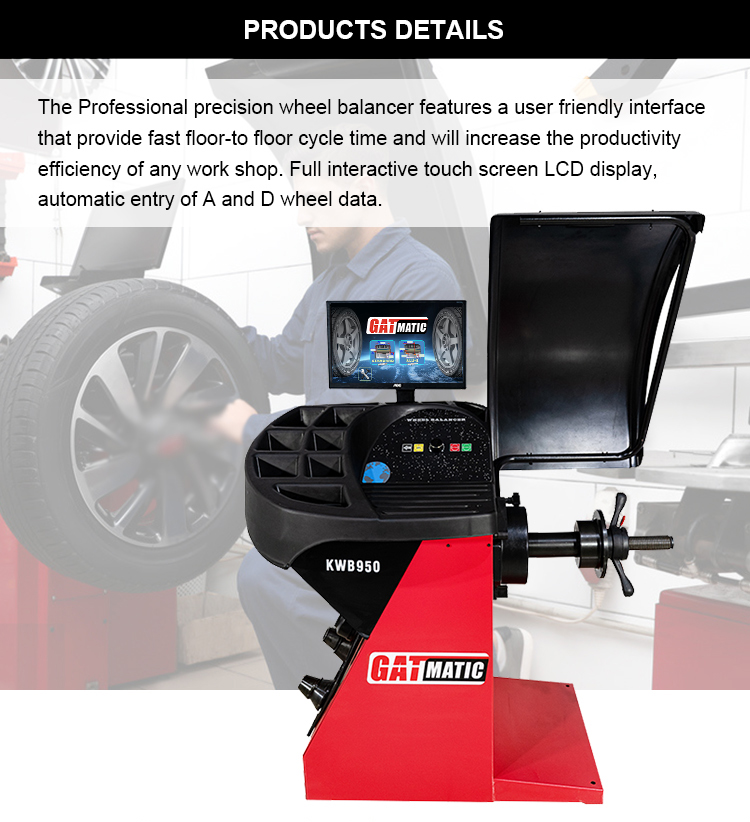The Crucial Role of Wheel Balancer Machines in Vehicle Maintenance
Vehicle maintenance is a cornerstone of ensuring safe and efficient transportation. One often-overlooked aspect of this maintenance is wheel balancing, a process facilitated by wheel balancer machines. In this essay, we will explore the importance of these machines in maintaining optimal vehicle performance, ensuring safety, and prolonging the lifespan of tires.
I. Understanding Wheel Balancing
Wheel balancing is a critical procedure that involves equalizing the weight distribution of a vehicle’s wheels. The impact of unbalanced wheels on vehicle performance is significant, leading to issues such as uneven tire wear, vibrations, and compromised handling. Proper wheel balance is essential for a smooth and stable ride, making it a fundamental aspect of routine vehicle maintenance.
II. Components and Functionality of Wheel Balancer Machines
Wheel balancer machines consist of various components designed to accurately assess and correct imbalances. Key components include the balancing shaft, sensor technology, and a user-friendly display interface. The balancing process involves an initial wheel assessment, application of counterweights, and verification of balance. This meticulous process ensures precise balancing, contributing to enhanced vehicle performance.
III. Benefits of Wheel Balancer Machines
The benefits of wheel balancer machines extend beyond immediate improvements in vehicle handling. Balanced wheels result in reduced vibrations, enhancing overall driving comfort. Moreover, the extended lifespan of tires, achieved by minimizing uneven wear, translates to significant cost savings for vehicle owners. The positive impact on fuel efficiency also adds to the economic advantages of regular wheel balancing.
IV. Wheel Balancer Machines and Safety
Safety is a paramount concern in the automotive industry, and properly balanced wheels play a crucial role in accident prevention. Unbalanced wheels can lead to compromised vehicle stability and handling, increasing the risk of accidents. Compliance with safety standards and regulations is not only a legal requirement but also a responsibility that wheel balancer machines help fulfill.
V. Types of Wheel Balancer Machines
Wheel balancer machines come in various types, including manual, semi-automatic, and fully automatic. Each type caters to different user preferences and operational requirements. Understanding the nuances of each type is crucial for making informed decisions when choosing the right wheel balancer machine for a particular setting.
VI. Maintenance and Calibration of Wheel Balancer Machines
To ensure consistent and accurate performance, wheel balancer machines require regular maintenance and calibration. Routine inspection, cleaning, and adherence to calibration procedures are essential practices. Moreover, providing adequate training for machine operators is crucial to guaranteeing the proper use and maintenance of these precision instruments.
VII. Challenges and Troubleshooting
Despite their effectiveness, wheel balancer machines may face challenges. Common issues such as sensor malfunctions or calibration discrepancies can impact performance. Troubleshooting tips are invaluable for addressing these challenges promptly, minimizing downtime, and ensuring the continuous functionality of the machines.
VIII. Integration with Modern Automotive Technology
Wheel balancer machines are not isolated entities; they are becoming increasingly integrated with modern automotive technology. Compatibility with advanced vehicle systems, connection to diagnostic tools and software, and the incorporation of artificial intelligence and machine learning are shaping the future of wheel balancing technology.
IX. Future Trends in Wheel Balancer Technology
Looking ahead, advancements in sensor technology, integration with artificial intelligence, and a focus on sustainability are shaping the future of wheel balancer technology. These trends underscore the industry’s commitment to continuous improvement and innovation in the quest for optimal vehicle performance and environmental responsibility.
Conclusion
In conclusion, wheel balancer machines play a pivotal role in vehicle maintenance, contributing to improved performance, enhanced safety, and prolonged tire lifespan. As technology evolves, these machines continue to adapt, providing essential support for the automotive industry. Vehicle owners and industry professionals alike must recognize and prioritize the crucial role that wheel balancer machines play in maintaining the health and longevity of our vehicles.
Get Access Now: https://www.gat-matic.com
FAQs
1. What is wheel balancing, and why is it essential for vehicle maintenance?
Wheel balancing is the process of equalizing the weight distribution of a vehicle’s wheels to ensure smooth and stable performance. It is crucial for maintaining optimal vehicle handling, preventing uneven tire wear, and ensuring a safe driving experience.
2. How do wheel balancer machines work?
Wheel balancer machines use sensor technology to assess the balance of each wheel. Based on the initial assessment, the machine applies counterweights to correct any imbalances. The process is usually displayed on a user-friendly interface for the operator to monitor.
3. What are the key components of wheel balancer machines?
Wheel balancer machines typically consist of a balancing shaft, sensor technology, and a display interface. The balancing shaft is responsible for rotating the wheel during the balancing process, while the sensors gather data to determine the weight distribution. The display interface provides real-time information on the balancing procedure.
4. What are the benefits of using wheel balancer machines?
Wheel balancer machines contribute to improved vehicle performance by reducing vibrations, enhancing handling, and extending tire lifespan. These benefits result in a more comfortable driving experience, cost savings due to reduced tire wear, and increased fuel efficiency.
5. How often should wheel balancing be performed on a vehicle?
Wheel balancing should be part of routine vehicle maintenance and is typically recommended whenever new tires are installed or when there are signs of uneven tire wear. Many experts suggest checking the balance during regular tire rotations, typically every 6,000 to 8,000 miles.
Describe Your Needs In Detail!
We will carefully evaluate your needs and give professional solutions.



